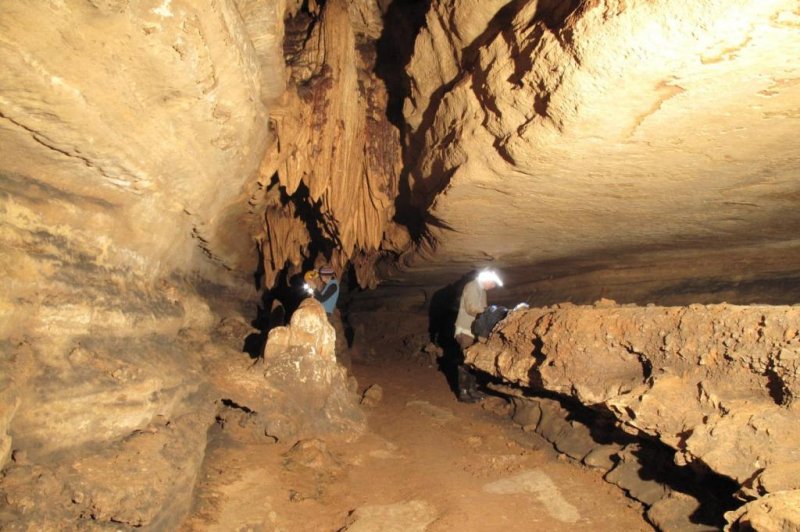Researchers dissected stalagmites in southern Indiana's Donnehue's Cave in search of evidence of ancient earthquakes. Photo by Sam Frushour
TERRE HAUTE, Ind., Sept. 13 (UPI) -- Evidence of ancient seismic activity in the Wabash Valley fault system may lie on the floor of several southern Indiana caves.
Growing from the floor of at least one of those caves are a series of stalagmites featuring evidence of past climatic events like glacial flooding. New research -- published this week in the Bulletin of the Seismological Society of America -- suggests these stalagmites may also reveal the timing of ancient earthquakes.
Stalagmites are cone-like mineral structures formed on the floor of a cave by mineral-rich water dripping from the ceiling. Seismic activity, as scientists explained in the new study, can shift the orientation of the stalagmites. An earthquake may close a water-leaking gap in the ceiling or dislodge a stalactite that had been feeding a corresponding stalagmite.
"When you take a stalagmite and slice it down its middle the long way and open it up like a book, you can see these shifts in the axis of its growth," Samuel Panno, a University of Illinois and Illinois State Geological Survey researcher, explained in a news release.
By dating the stalagmite, as well as surrounding rock and soil, researchers can pinpoint the timing of these axis shifts and create a timeline of ancient seismic events.
An analysis of several stalagmites in Donnehue's Cave revealed a twin pair that stopped growing more than 100,000 years ago, and then began accumulating minerals again some 6,000 years ago -- around the time the region experienced a 7.1- to 7.3-magnitude earthquake.
Another stalagmite appeared to have been birthed by a magnitude-6.2 earthquake, which struck 1,800 years ago. The same stalagmite features axis shifts corresponding with seismic activity in the nearby New Madrid Seismic Zone.
Previously, scientists have plotted the history of earthquakes over the last several thousand years by studying evidence of soil shaking precipitated by earthquakes -- a process known as paleoliquefaction.
"Most of the evidence for paleoearthquakes comes from liquefaction features that are fairly easy to date," Panno explained. "The problem is that you are doing this in sediments that are usually on the order of several hundred to up to 20,000 years old, so to go beyond that, to get older and older earthquake signatures, we decided to look into caves."
Another complicating factor is the interference of glacial flooding, which can also rearrange and reorient stalagmites.
But researchers believe further study of the cave floor phenomenon will allow them to differentiate between evidence of ancient earthquakes and glacial flooding.















